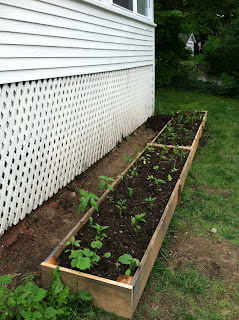It is great advice to work smarter, not harder. But sometimes it takes the experience of working harder first to make you ponder, "Shouldn't there be an easier way?"
Case in point - cleaning out the chicken coop.
Here's some background - We use the deep litter method with our chickens, which is an unoffensive way to describe the rather unglamorous piling-up of chicken poo and pine shavings. Instead of cleaning the chicken coop like a cat litter box (i.e. always in cleaning mode), you cover the animal waste periodically with a new layer of pine shavings and allow a deep layer to accumulate over time. This is a low-maintenance way to keep chickens, but eventually you will need to actually clean out the coop.
Now, jump to a sunny day two weeks ago - I decide that I REALLY need to clean the chicken coop before winter, and that today is THE day. I open the chicken coop, and immediately notice the big pile of chicken litter directly underneath the chickens' roosts and on the edge of one of the nest boxes. It is enormous compared to the layers of chicken litter over by the food and water dishes.
Hmmm... I wonder if I can reduce the number of times that I need to clean out the whole chicken coop, if I start doing routine maintenance work in the chicken roost area, where 90% of the feces are headed. Wouldn't that be easier?
Yes. (Duh.)
Turns out that it's much easier to do some "kitty litter box" maintenance in the areas where chicken poo accumulates rapidly, and continue with the deep litter method in the rest of the coop. It's sort of a shame that this revelation has taken a year and a half to arrive, but I can already tell a difference.
***
 |
| Cranberries for syrup, apples for sauce. |
In other news, this month's Can It Up challenge was for cranberries. I'm trying a new recipe each month in super small batches, so I can experiment a little without investing a lot in ingredients or time.
I'm a huge fan of pickled cranberries from Marisa at Food in Jars, but I had another recipe from Marisa's cookbook that I wanted to try - CRANBERRY SYRUP!
I love the simplicity of this recipe -
1) Put cranberries in pot, add water, boil until cranberries pop.
2) Strain juice from cranberry pulp.
3) Add sugar to juice, boil until mixture is syrupy.
4) Ladle into jars and preserve in a boiling water bath.
The verdict - I think I may have cooked the cranberry syrup too much, as the syrup has a soft set, almost like a runny jelly. It tastes fine, but doesn't dissolve well in sparkling water to make a cranberry spritzer.
I need to figure out some other ways to use my cranberry syrup/jelly - any ideas?
 |
| Deep red juice drips from boiled cranberries. |




































